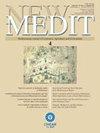The emerging saffron value chain in the M’Zab valley – southern Algeria: an analysis of ongoing dynamics and strategic development options
IF 1.2
4区 经济学
Q3 AGRICULTURAL ECONOMICS & POLICY
引用次数: 0
Abstract
The saffron growing has emerged over the last decade in Algeria and has diffused in different agroclimatic regions, especially in the M'Zab valley and its periphery in the Saharan region of the country. This study sets out to analyze the emerging saffron value chain in the M’Zab valley and suggests strategic options for strengthening its development. The analysis was based on a case study. The methodology applied the tools of value chain analysis in its positive and normative dimensions: a combination of qualitative and quantitative approaches based on the triangulation of data collection methods (interviews, secondary data collection, direct observations). A participatory approach was used to make a SWOT analysis and to propose strategies for developing the value chain. The results showed that the local saffron value chain has strengths (proftabilty and quality) and opportunities (growing demand of healthy and natural products), but its performance is limited by weaknesses (producers skills, marketing) and threats (Fraud or counterfeiting related to imported saffron) mainly related to the deficiencies in the institutional environment. Recommendations are made for elaborating a national saffron export strategy and building a competitive value chain able to take advantage of the expected growth in world demand.阿尔及利亚南部M'Zab山谷新兴的藏红花价值链:持续动态和战略发展选择分析
藏红花在过去十年中在阿尔及利亚出现,并在不同的农业气候地区传播,特别是在该国撒哈拉地区的M'Zab山谷及其周边地区。本研究旨在分析M'Zab山谷新兴的藏红花价值链,并提出加强其发展的战略选择。该分析基于一个案例研究。该方法在积极和规范层面应用了价值链分析工具:在数据收集方法(访谈、二次数据收集、直接观察)三角化的基础上,结合了定性和定量方法。采用参与式方法进行SWOT分析,并提出发展价值链的战略。结果表明,当地藏红花价值链具有优势(专业性和质量)和机会(对健康和天然产品的需求不断增长),但其表现受到弱点(生产商技能、营销)和威胁(与进口藏红花相关的欺诈或假冒)的限制,这主要与制度环境的缺陷有关。建议制定国家藏红花出口战略,建立一个能够利用世界需求预期增长的有竞争力的价值链。
本文章由计算机程序翻译,如有差异,请以英文原文为准。
求助全文
约1分钟内获得全文
求助全文
来源期刊

New Medit
AGRICULTURE, MULTIDISCIPLINARY-
CiteScore
2.00
自引率
30.00%
发文量
31
审稿时长
>12 weeks
期刊介绍:
New Medit is an applied economics journal, with a multidisciplinary approach, aimed at providing insights into the economic and the social transformations of agro-food sector, rural societies as well as local development and bioeconomy in the Mediterranean Basin.
Manuscripts submitted to NEW MEDIT generally should deal with wide-ranging topics that can be extended to other countries where organisational, production and market conditions and the related development policies may emerge at the corporate or regional level.
 求助内容:
求助内容: 应助结果提醒方式:
应助结果提醒方式:


